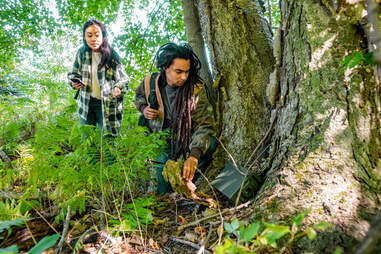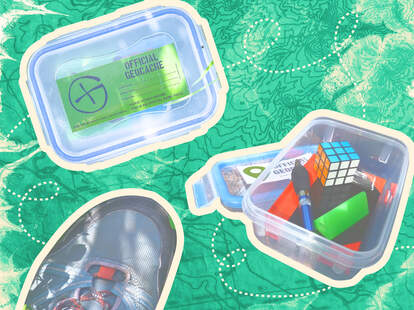A beginner’s guide to geocaching, the worldwide treasure hunt happening right under your nose.

Geocaching is the treasure hunt we didn’t know we needed. | Image by Grace Han for Thrillist
Geocaching is the treasure hunt we didn’t know we needed. | Image by Grace Han for Thrillist
It’s not often you find yourself 100% ready and willing to squat down on your knees in the middle of New York City in the rain. Still, there I was, down low on the concrete, checking every inch of an old abandoned newspaper box. It was the end of a day-long journey that’d sent me wandering around Soho and Tribeca, along random streets in Midtown, and at last to a quiet street corner just outside Grand Central.
I was out geocaching. For the uninitiated, geocaching is essentially one big worldwide treasure hunt in which people place caches—containers of various shapes and sizes—in secret locations, then drop a set of coordinates and clues to help members of the community find them.The first cache was placed over 20 years ago by Dave Ulmer of Beavercreek, Oregon; today, there are about 3 million spread across more than 190 countries—meaning that wherever you are, there’s probably one hidden right under your nose.
The caches, filled with everything from basic guest logs to fun little trinkets, come with all kinds of stories attached to them. I’ve found caches placed in honor of birthdays and beloved pets, as history lessons and small tokens of appreciation to the city. Once I spent an afternoon traipsing up and down Staple Street in pursuit of a cache placed there by a New Yorker who simply wanted more people to come and admire the block.
After spending the better part of the last year and a half indoors, the game presented the perfect opportunity to get back outside and rediscover the world around me—every random nook and cranny of it.

I’m not the only one. Chris Pierno, a federal contractor who lives in DC, was like me: A “COVID Cacher,” somebody who started geocaching in the throes of the virus.
“[Geocaching] has been around for a long time, so obviously, activity ebbs and flows. But the community has seen an influx of people starting accounts primarily due to COVID,” Pierno says. In just six months he’s found more than 500 caches—many in places he’d passed by a thousand times before. “It’s like, how cool is this: That this thing is just there, outside of a restaurant that you’ve been to a bajillion times, and you didn’t even know it.”
It takes a couple of tries to get into the game, but once you channel your inner Harriet the Spy (or Sherlock Holmes, or whichever puzzle-solving cultural icon you vibe with) you’ll soon find yourself giddily solving clues, cracking open hidden boxes, and remembering that little secrets are all around us if we just look for them.

How does geocaching work?
Download the free Geocaching app and sign up. I’d recommend dropping the extra $6 on a premium account if you can: It’ll give you access to way more caches than a standard account.
Input your zip code and your screen will fill up with caches in your area. Select the cache you want to find—I recommend starting with a “traditional” cache, marked with a green icon—and check out the description page. There, you’ll find details like whether the cache is available 24/7, how long it should take to find, its size and difficulty level, plus a hint and description. Read the latter two carefully: Not only do they add some fun context to the cache, but they’ll also help you uncover its location. Then, it’s off to the races.
Oh yeah, and bring a pen. You’ll need one to sign the cache log, aka the cache’s guestbook—a list of everyone who’s ever discovered it.
What do caches look like?
All caches must be outside and relatively accessible—meaning you won’t need to break and enter and weave Bond-like through lasers to find one. But caches do come in many forms.
Traditional caches are the most straightforward: you’ll go to a location, find the cache container, and sign the log. Multi-caches take a little more effort: they usually involve solving a series of clues that’ll take you to two or more locations until you reach the cache. To find a mystery cache (aka a puzzle cache), you’ll often need to solve some sort of puzzle. You can get a full list of cache types here.
Caches come in a few different sizes, too: nano, micro, small, regular, large, and other. When I say nano, I mean nano; these caches can be as tiny as an eraser cap. Micro caches are generally around the size of a chapstick tube, while small caches tend to be the size of a film canister or a pill bottle—and so on up.

What’s inside?
While small caches tend to have room enough for the log sheet alone, larger caches may come with a little fun inside. Some caches contain “trackables”—items you’re meant to take from one cache and move to another, logging it along the way so that the person who placed it can track its journey. Others have collectibles inside, which tend to be fun, inexpensive knick-knacks: action figures, fun erasers, and other chachkies—the kinds of things you might get for a couple hundred tickets at an arcade.
How to find a cache
Head to the cache’s general location, and then hit “Navigate” in the app to see its exact coordinates and roughly how far away you are in feet. Caches are hidden out of the way—after all, you only want people who are playing the game to find them—so keep an eye out for inconspicuous nooks and crannies.
If you’re really struggling, head to the description page and hit “Activity.” You’ll be able to check out other cachers’ stories, some of which may include pictures so you’ll know exactly what you’re looking for.
Once you’ve found the cache, sign the log and return the cache exactly as it was so that the game can go on. Back on the Activity page, you can detail your success story—or, if you just can’t find the damn thing, report it as a DNF (or “did not find”). Sometimes caches go missing, and you’ll want to let the person who placed it know.

Don’t be surprised if it takes a while to find
I came out of the gate way overconfident and expected my first cache to be a cakewalk. But after skulking up and down the same street about a thousand times, checking the same potted plants again and again, and generally looking like a complete weirdo, I realized it takes some patience and diligence to uncover a cache.
“I found my first cache on a Target run,” Pierno recalls. “It ended up being in a birdhouse, in a tree, in a parking lot behind the store. That’s not necessarily the experience most people get; it’s usually on a guardrail or in a pill bottle!”
Pro-tip: Always check the lamp skirts. “I didn’t know before I started geocaching that lamp skirts existed,” he says. “I didn’t know that they can be pulled up. But you’re gonna spend a lot of time in parking lots pulling those lamp skirts up and down.” The more you know!

You’re going to look weird. Maybe bring a friend to look weird with you?
Naturally, if you’re snooping around in bushes or in strange corners along the same street, you’re going to raise a few eyebrows. But the anxiety around looking weird may keep you from the find—and the sooner you defeat it, the sooner you can enjoy the game.
Pierno recommends recruiting some pals to make things more fun. Hell, it might even lead to a weekend trip. “A group of friends and I actually traveled to go geocaching. We rented an Airbnb in Berkeley County, West Virginia, where there’s known to be really cool gadget caches,” Pierno says. “We went and spent the weekend and found 30-40 caches.”
Try to be discreet
Geocaching operates on the honor system: If you’re going to play, you know that you’re not supposed to remove a cache from its place. But you also want to ensure the cache continues to be there after you’ve left—which means keeping an eye out for potential cache-snatchers.
“If someone sees you, they may be waiting for you to go away,” says Pierno. “And then they’re going to go check out whatever you were looking at…and all of a sudden, that cache is gone, because people just like taking things, and then you’ve ruined it for someone else. There’s always the danger of messing up the game.”
Consider waiting until there’s low foot traffic to remove the cache from its place—especially if you’re caching in an urban area.

Got the hang of it? Now hide your own geocache!
If you want to place a cache of your own, there are some rules you’ll need to abide by: geocaches must be located at least 0.1 miles apart, they can’t be buried, they should be widely accessible, and a few other things.
Volunteers will review the submission, and then it’ll go live on the app. Just keep an eye on your listing once it’s up—people may message you looking for hints, and you’ll eventually need to replace the cache log once enough people find it.
Whether you’re building your own cache or contributing to someone else’s, consider leaving something meaningful or customized—sort of like your own personal calling card. “If you do want to invest some time into [geocaching], I would consider going that personalized route and leaving behind a signature item—whether that’s going the extra mile and creating a little coin that’s specific to who you are, or getting a stamp to sign your name.”
“Personally,” Pierno adds, “I’ve been buying mini brands, these plastic balls that you buy at a Target or Walmart, and they have five little compartments in them with miniaturized versions of food—a miniature Soubrette hotdog, or Kraft macaroni and cheese, or Barilla pasta.”
I, for one, did not know that these existed but would be ecstatic and delighted to find one. One cacher’s trinket is another cacher’s treasure, after all.
Our Newsletter








